Synopsis:
Here we will gain an understanding and reasoning for the 3 distinct pillars (Formulation, Implementation, and Execution) that make up strategy management.
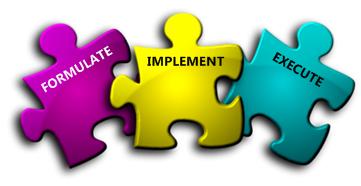
As I mentioned in Why Good Strategies Go Bad, not understanding the differences between the 3 pillars and the importance of a distinct implementation process can ultimately lead to failure in achieving strategic targets. A distinct strategy implementation process provides the vital connection between formulation and execution. Without it your technical group may be doing things right, but they may not be doing the right things.

“There is surely nothing quite so useless as doing with great efficiency what should not be done at all.” [i]
Peter F. Drucker
We’ve all heard the phrase “go with your gut.” But should management really be funding projects based on supposition and emotion? And we’ve also heard about how building a business takes perseverance, commitment, and determination. While these are important attributes for every company executive or entrepreneur, perseverance, commitment, and determination alone may not be enough to get you to your goal. Following a strategy management process will guide the activities, roles, and responsibilities in the formulation, implementation, and execution of your goals and will significantly increase your probability of success.
The First Pillar: Strategy Formulation - Creating a Strategy Framework
Strategy formulation is the process of developing the most effective approach to achieving a stated long-term goal. It begins by leveraging both internal and external factors that affect your organization and establishes the guidelines needed for the critical decisions you will make during strategy implementation. To begin formulating a strategy framework, you’ll need a clear long-term goal, an understanding of your operating environment, and a good idea of where your market’s going. Having this information will help you build a framework that will provide the direction needed to both support and constrain implementation decisions. Your strategy framework is not a complex document describing all the projects, activities, and planned achievements you feel are needed to reach your goal—a common mistake. See figure 1.
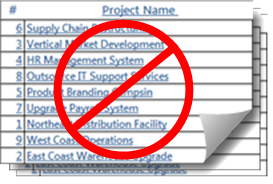
Figure 1: A project list
Simply developing a list of projects can lead to two potential problems:
- The project selection process may be corrupted by politics, self-interest, and other negative influences, resulting in the selection of potentially questionable projects
- A commitment to complete projects that, through changing conditions, no longer provide a strategic value
A good strategy framework will prevent these problems by providing the guidelines for maintaining direction and continuity in the project selection and management processes that occurs during strategy implementation. Your strategy framework is closely akin to company policy. Its emphasis is on how the value chain will conduct business in order to achieve your organizational long term goals. See Figure 2.
Later in this series of articles I'll provide more information and a process for creating a strategic framework.
The Second Pillar: Strategy Implementation – Doing the Right Things
At the core of a strategy implementation process is the assessment of ideas and project proposals that allows you to choose the most effective projects needed to reach your goals. A strategy implementation process applies tools and techniques that focus on helping you choose the right things to do. Let’s take a look at how that works. For years information technology research companies have promoted some form of Cartesian coordinate system to assist us with decision-making. See Figure 3. This technique has proven to be quite effective in several different forms.
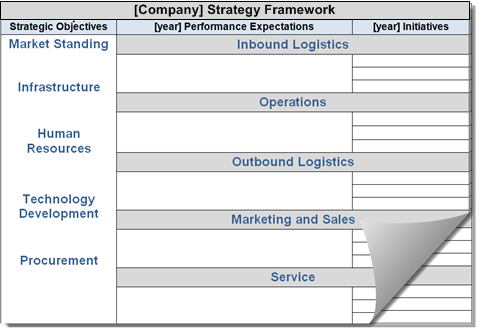
Figure 2: Strategy framework template
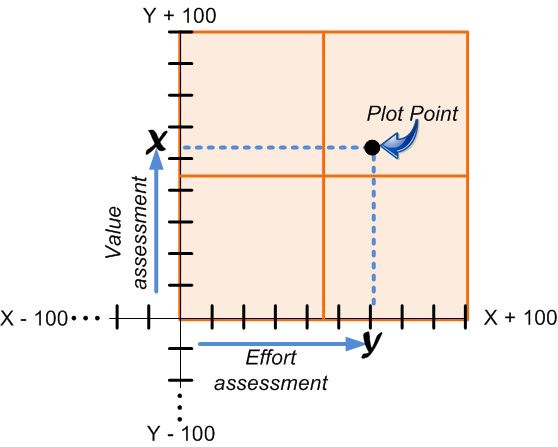
Figure 3: Cartesian coordinate system
After scoring an idea or proposal against a common set of strategy based assessment arguments, the resulting math calculates a coordinate to be displayed as a plot point on the chart depicting the proposal’s value and required effort. This Cartesian based assessment is at the heart of strategy implementation. Conceptually this step acts as a funnel for ideas and proposals clearly showing what should be done, what could be done, and what should not be done. See figure 4.
You could increase the level of sophistication with this process by adding a Cartesian coordinate system where the "X" axis contains scoring arguments for risk effect and the "Y" axis contains scoring arguments for realization probability. You may also add a single scoring scale for priority.
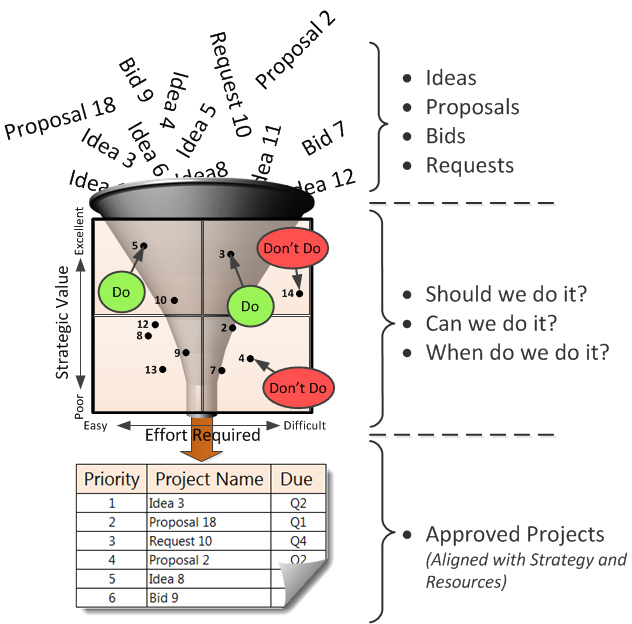
The final analysis will produce unbiased and unarguable answers to should we do it, can we do it, and when do we do it.
When your active projects and new project proposals are collectively displayed, it’s easy to see what you should be doing and what you should not be doing. Having the tools, process, and culture for strategy implementation will provide the project selection and communication needed to achieve your strategic targets. This process allows you to:
- Promote transparency regarding project selection & prioritization
- Build and manage a portfolio of high-value projects and avoid the cost of low-value projects
- Compare consolidated information on a comprehensive dashboard
- Track each project’s progress against your expectations and continued value
- Coordinate project inter-dependencies
If you would like to look at a strategy implementation application, please visit the software section of this site. Later in this series of articles I'll provide more information on how you can develop your unique strategy based assessment arguments.
The Third Pillar: Strategy Execution - Doing Things Right
Once you have an approved project, it’s now time for action. The project must be executed. So how will you know whether you are doing things right? Typically, doing things right falls to the project managers or the project office. They hold a lot of responsibility for how to get things done. While organizations like PMI, IPMA, and ISO promote many project management skills and quality requirements, I feel that there are just four critical success factors that a manager needs to be actively involved with in order to do things right. They are:
- Managing project estimates
- Managing project communication
- Managing the knowledge community
- Managing the project constraints
Let’s take a closer look at at just one of these critical success factors and how we can recognize if we’re doing things right.
Managing the Project Constraints
Project constraints are rules that are put in place to identify and protect the project from unwarranted scope creep, which can be an expansion of project requirements or a change in expectations. It is important to understand that scope creep is not necessarily bad thing. Project requirements and expectations are seldom accurate and complete before starting the project. Over time, changes to the constraints can be expected. It's really about how we handle these changes that identify whether we are doing things right...or not. Remember, a battle plan is only good until the battle starts.
Project planning starts when you prioritize the three main project constraints: Performance, Cost, and Schedule. Choose one of these constraints to be the project driver, which is the highest priority constraint. For example, if you choose schedule as the constraint driver, you are telling your team that not meeting schedule will result in project failure.
We have all heard someone demand "I want it good, I want it cheap, and I want it now!" If you haven't heard that by now, you will. These people walk among us. When they get their way, your project is doomed from the start. You can't run a project when all three constraints are priority one. If you do, your doing things wrong!
There are lots of people, including sponsors and other stake holders, who are very good at adding requirements after the project has started. More often that not, these additional requirements come in small increments, but over time they can add up and overwhelm the plan, putting your project at risk. When managing project constraints, part of doing things right means having a process in place that provides for :
- Changing project constraint priorities
- Conducting a change request impact assessment
- Authority to negotiate, accept, and reject change requests
- Authority to update the detailed project plan and broadly communicate new expectations

